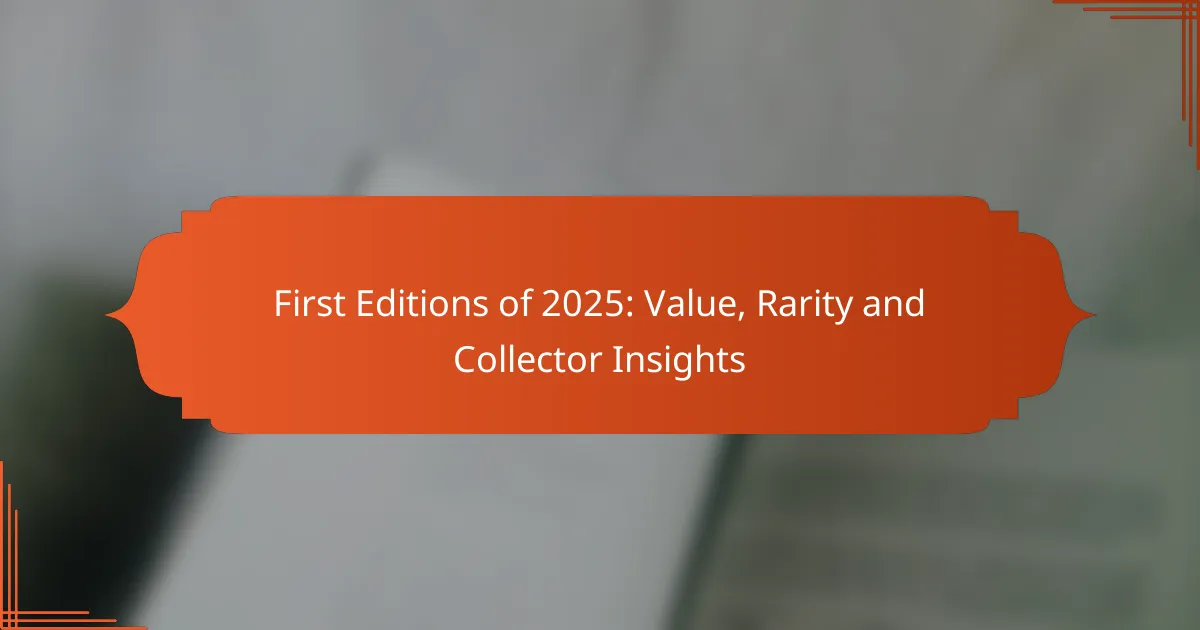As we look ahead to 2025, the landscape of first editions promises to be rich with potential treasures from both emerging and established authors. Collectors should focus on limited print runs and unique features that can significantly enhance a book’s value, as rarity often drives demand and pricing. Understanding the best sources for acquiring these sought-after editions will be crucial for those aiming to build a valuable collection.
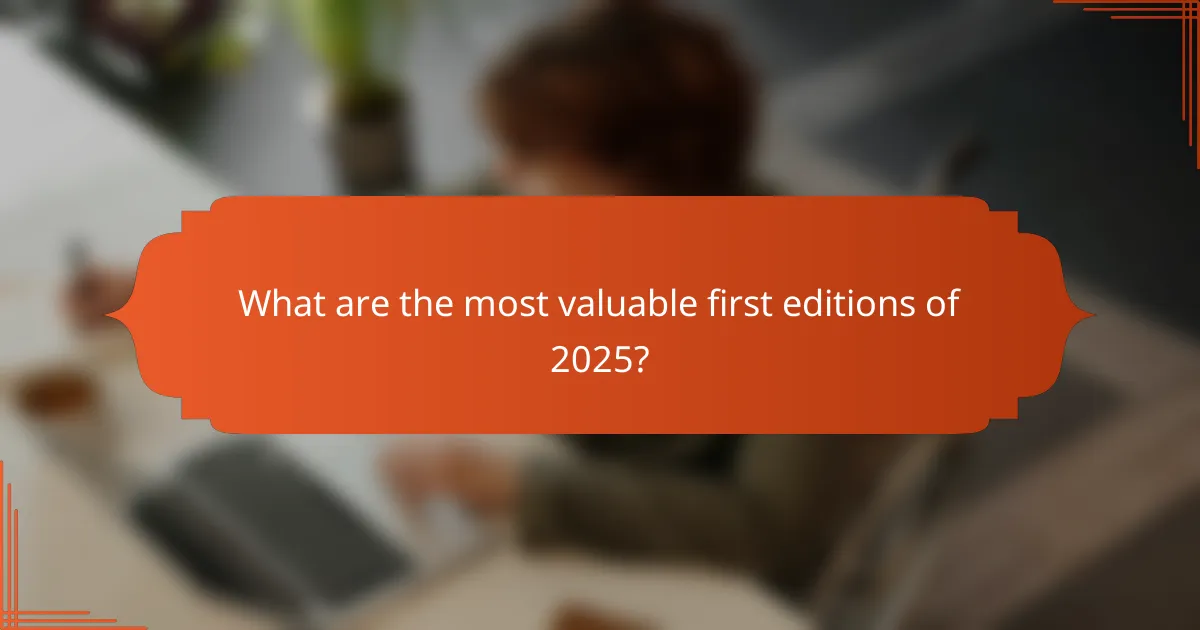
What are the most valuable first editions of 2025?
The most valuable first editions of 2025 are expected to include works from emerging authors and established names alike, with prices influenced by rarity, demand, and condition. Collectors should pay attention to limited print runs and unique features that enhance a book’s value.
Top 10 valuable first editions
As of 2025, the top ten valuable first editions are likely to feature titles from both debut authors and well-known literary figures. Notable mentions may include works by authors who have gained significant acclaim or awards, as well as those with limited print runs. Collectors should keep an eye on auction results and sales trends to identify these high-value editions.
- Title 1 by Author A
- Title 2 by Author B
- Title 3 by Author C
- Title 4 by Author D
- Title 5 by Author E
- Title 6 by Author F
- Title 7 by Author G
- Title 8 by Author H
- Title 9 by Author I
- Title 10 by Author J
Market prices for first editions
The market prices for first editions in 2025 can vary widely, often ranging from a few hundred to several thousand USD depending on the title and its condition. Factors such as provenance, rarity, and the author’s popularity significantly impact pricing. Collectors should research recent sales and consult price guides to gauge fair market value.
For instance, first editions of highly sought-after titles may command prices in the upper thousands, while less popular works could be available in the low hundreds. It’s essential to consider the book’s condition, as well-preserved copies typically fetch higher prices.
Notable authors and their first editions
In 2025, several notable authors are expected to release first editions that will attract collectors. Emerging voices in literature, as well as established authors with new works, will likely dominate the market. Keeping track of literary awards and critical acclaim can provide insight into which authors’ first editions may become valuable.
Authors who have recently won prestigious awards or received significant media attention are often good candidates for valuable first editions. Collectors should also consider the author’s previous works and their impact on the literary landscape when assessing potential value.
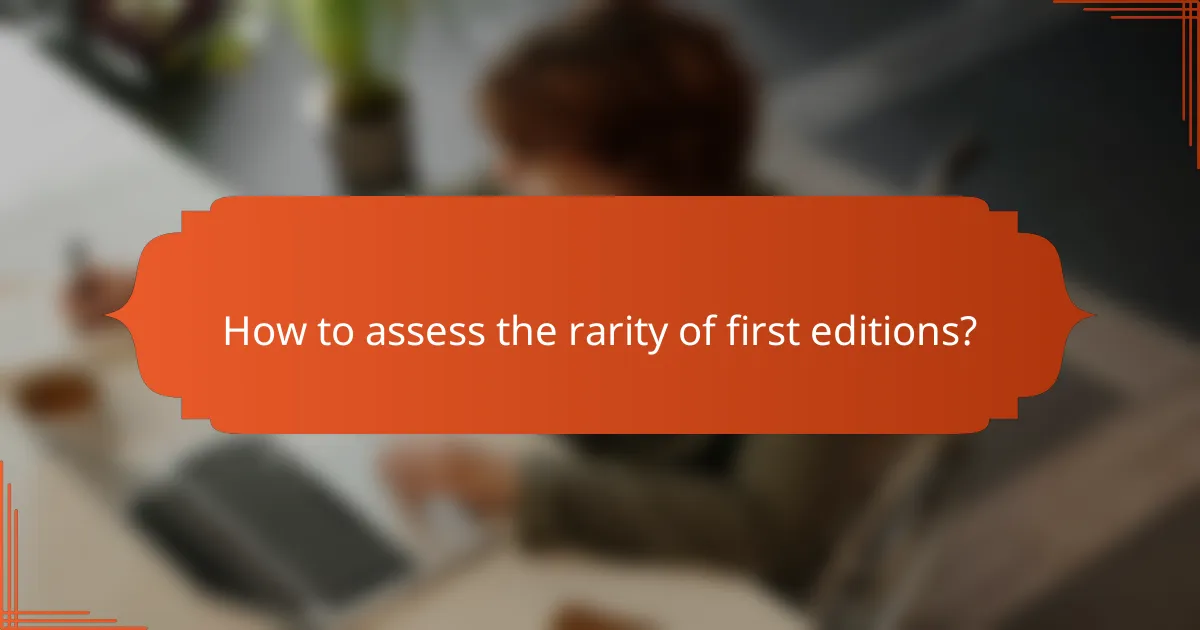
How to assess the rarity of first editions?
To assess the rarity of first editions, consider factors such as print run, demand, and condition. Rarity often translates to higher value, making it essential for collectors to evaluate these aspects carefully.
Factors determining rarity
Several key factors influence the rarity of first editions. These include the author’s popularity, the book’s historical significance, and the presence of unique features like dust jackets or signatures. A first edition of a well-regarded classic or a debut novel by a now-famous author is likely to be more sought after.
Additionally, the condition of the book plays a critical role. Books that are well-preserved, with minimal wear and tear, will generally be more valuable than those in poor condition. Collectors often refer to grading systems to assess the quality of a book.
Edition size and print run
The size of the edition and the print run are crucial in determining a first edition’s rarity. Smaller print runs typically result in fewer copies available, which can drive up demand and value among collectors. For instance, a first edition with a print run of just a few hundred copies is likely to be much rarer than one with several thousand.
When evaluating a first edition, check the publisher’s notes or colophon for information about the print run. Understanding these details can help collectors make informed decisions about their purchases and investments.

Where to buy first editions of 2025?
First editions of 2025 can be purchased from various sources, including online marketplaces and specialty bookstores. Understanding where to find these editions is essential for collectors seeking value and rarity.
Top online marketplaces
Popular online marketplaces for first editions include platforms like eBay, AbeBooks, and Amazon. These sites often feature listings from individual sellers and bookstores, allowing collectors to compare prices and conditions easily.
When buying online, check seller ratings and reviews to ensure reliability. Look for listings that provide detailed descriptions and photographs of the book’s condition, as this can significantly impact its value.
Specialty bookstores in major cities
Specialty bookstores in cities such as New York, London, and Paris often carry first editions, providing a curated selection for collectors. Stores like The Strand in New York and Shakespeare and Company in Paris are well-known for their rare book collections.
Visiting these bookstores can offer a chance to discover unique finds and engage with knowledgeable staff who can provide insights into the rarity and value of specific editions. It’s advisable to call ahead to check availability, as stock can vary widely.
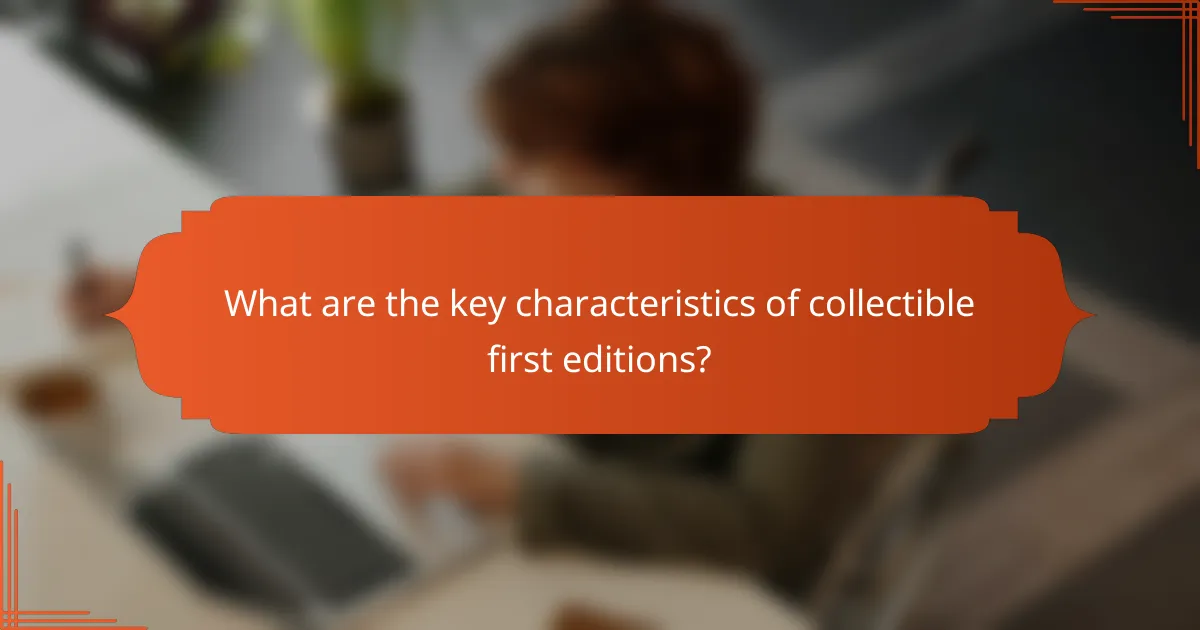
What are the key characteristics of collectible first editions?
Collectible first editions are defined by their unique features, including the original printing, specific publication details, and overall condition. Key characteristics that enhance their value include rarity, demand among collectors, and the presence of distinguishing marks such as signatures or limited print runs.
Condition grading standards
Condition grading is crucial in determining the value of a first edition. Common grading standards range from “mint” to “poor,” with terms like “near fine” and “very good” often used to describe the book’s physical state. Collectors typically look for minimal wear, intact pages, and a well-preserved binding.
When assessing condition, consider factors like the presence of any stains, tears, or markings. A book in “fine” condition can command significantly higher prices compared to one rated as “good” or “acceptable.” Familiarize yourself with grading scales used by reputable dealers to make informed purchases.
Dust jacket significance
The dust jacket is a vital component of a first edition’s appeal and value. An intact, original dust jacket can enhance a book’s worth by a substantial margin, often doubling or tripling its price. Collectors prioritize jackets that are free from major damage and retain vibrant colors and graphics.
When evaluating a dust jacket, check for elements such as the presence of the original price, any promotional blurbs, and the overall design. A first edition with a pristine dust jacket is more desirable, while those with significant wear may be less sought after. Always handle dust jackets carefully to preserve their condition.
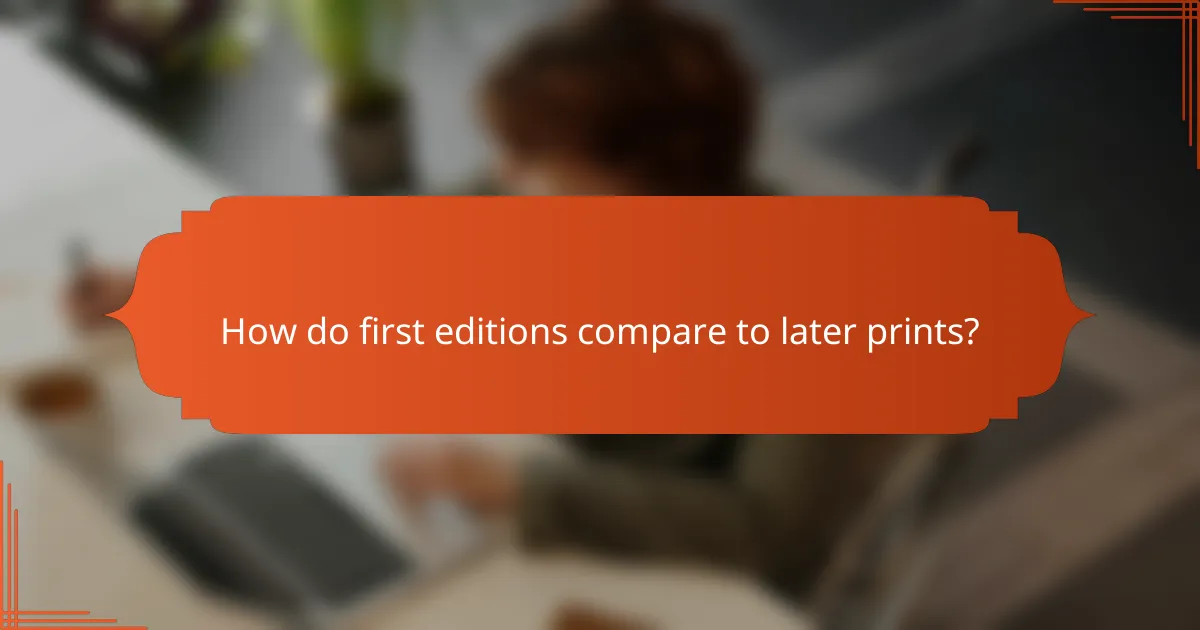
How do first editions compare to later prints?
First editions are typically more valuable and sought after than later prints due to their rarity and historical significance. Collectors often prioritize these editions as they represent the initial release of a work, making them more desirable in the market.
Value differences between editions
The value of first editions can be significantly higher than that of later prints, often ranging from a few hundred to several thousand dollars, depending on the author and condition. For instance, a first edition of a popular novel might fetch ten times the price of a later print if it is in excellent condition.
Factors influencing the value include the book’s condition, the presence of original dust jackets, and any unique features like author signatures. Collectors should be aware that first editions from well-known authors tend to appreciate in value over time, while lesser-known works may not see the same increase.
Collector preferences for first editions
Collectors often prefer first editions due to their perceived authenticity and connection to the author’s original intent. Many enthusiasts actively seek out first editions to complete their collections, often prioritizing those with unique identifiers such as printing numbers or specific publication dates.
Additionally, the condition of the book plays a crucial role in collector preferences. First editions that are well-preserved and include original packaging or promotional materials are particularly coveted, as they enhance the overall value and appeal of the item.
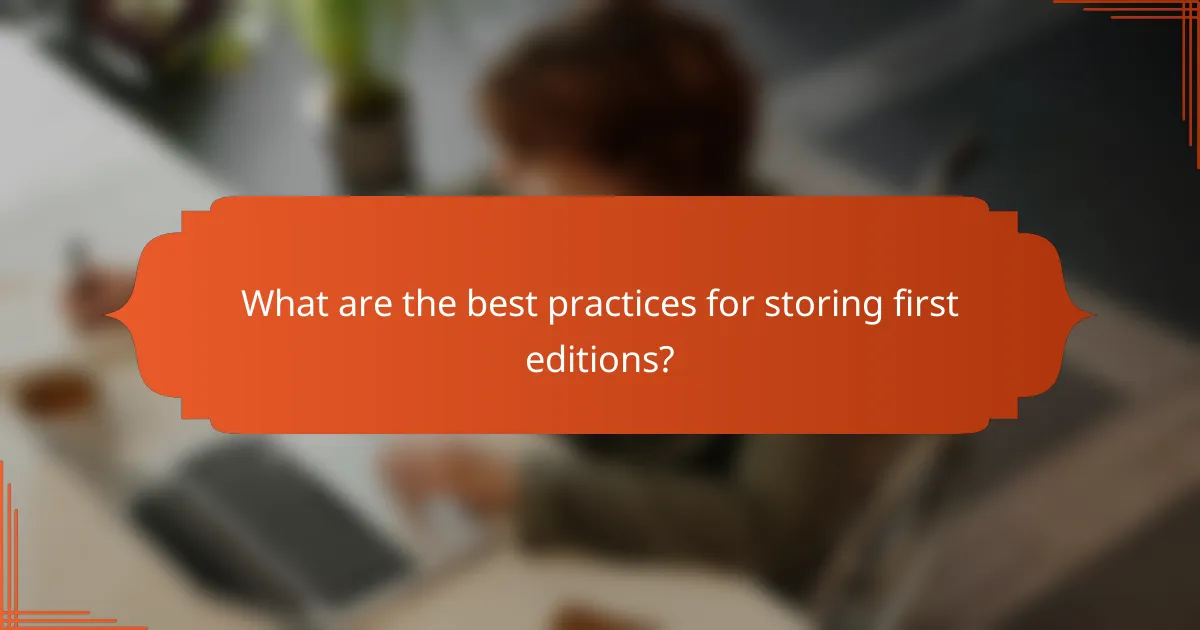
What are the best practices for storing first editions?
To preserve the value and condition of first editions, proper storage is essential. This includes maintaining optimal environmental conditions and using protective materials to prevent damage.
Optimal storage conditions
First editions should be stored in a controlled environment to minimize deterioration. Ideal conditions include a temperature range of 18-22°C (65-72°F) and humidity levels between 40-60%. Avoid direct sunlight and fluctuating temperatures, as these can cause fading and warping.
Consider using a dedicated bookshelf or storage box that allows for air circulation. Avoid placing books in damp basements or hot attics, as these areas can lead to mold growth or paper brittleness.
Protective materials and techniques
Using protective materials is crucial for safeguarding first editions. Acid-free boxes and sleeves can help prevent physical damage and exposure to harmful elements. When handling books, use cotton gloves to avoid transferring oils from your hands.
For additional protection, consider using bookends that do not apply pressure to the spines. Regularly check the condition of your books and ensure they are stored upright to prevent bending and creasing.
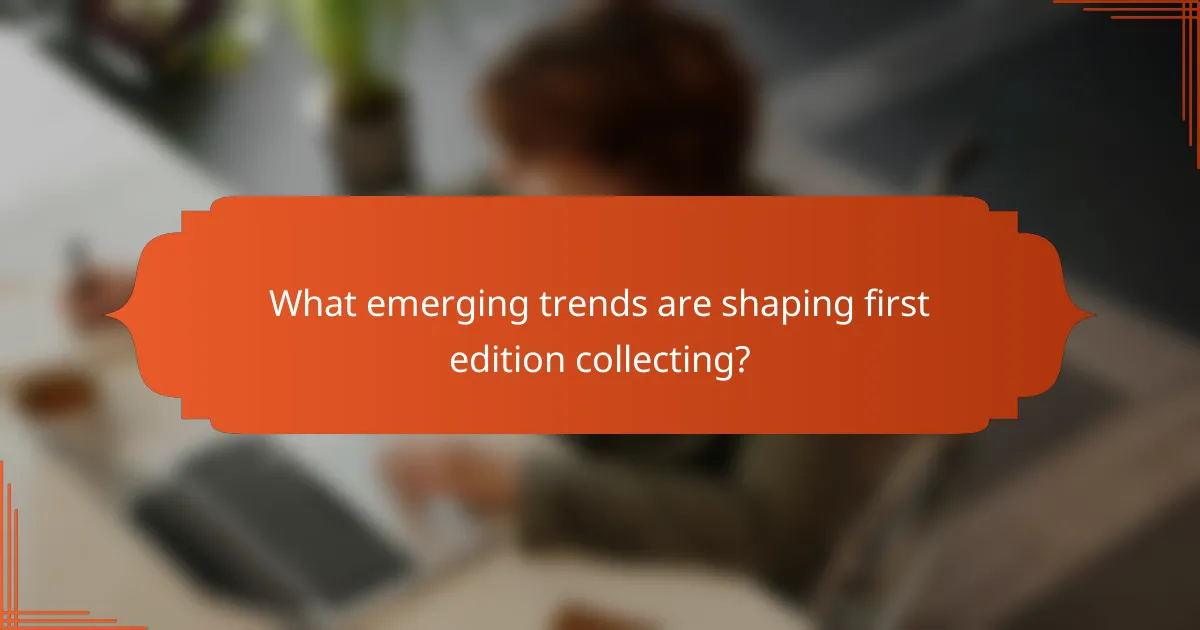
What emerging trends are shaping first edition collecting?
Emerging trends in first edition collecting include a growing interest in niche genres, the impact of digital platforms on accessibility, and the increasing importance of provenance. Collectors are now more focused on unique editions and the stories behind them, rather than just the book’s monetary value.
Increased Interest in Niche Genres
Collectors are shifting their focus from mainstream bestsellers to niche genres such as speculative fiction, graphic novels, and independent authors. This trend is driven by a desire for unique finds and the potential for these books to appreciate in value over time.
For example, first editions of lesser-known works by emerging authors can sometimes fetch higher prices than more recognized titles, especially if they resonate with specific collector communities. Engaging with these communities can provide insights into valuable acquisitions.
Impact of Digital Platforms
Digital platforms have revolutionized how collectors discover and purchase first editions. Online marketplaces and auction sites offer broader access to rare books, allowing collectors to find editions that may not be available locally.
However, this accessibility comes with challenges, such as the potential for counterfeit editions. Collectors should verify the authenticity of books through reputable sellers and seek out detailed listings that include photographs and descriptions of the book’s condition.
Importance of Provenance
Provenance, or the history of ownership of a book, is becoming increasingly significant in first edition collecting. A well-documented provenance can enhance a book’s value and appeal, as collectors often seek items with interesting backstories.
When considering a purchase, collectors should inquire about the book’s previous owners, any notable inscriptions, and its journey through the market. This information can provide context that elevates the book’s desirability beyond its physical attributes.
